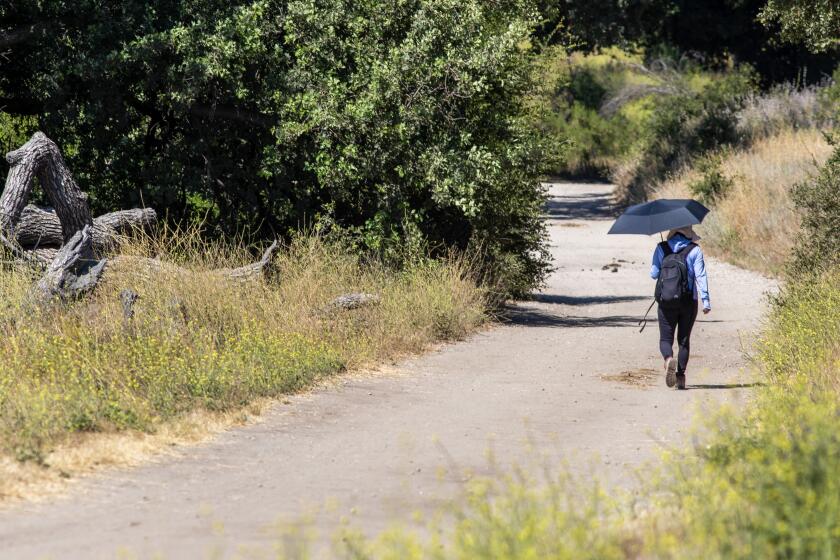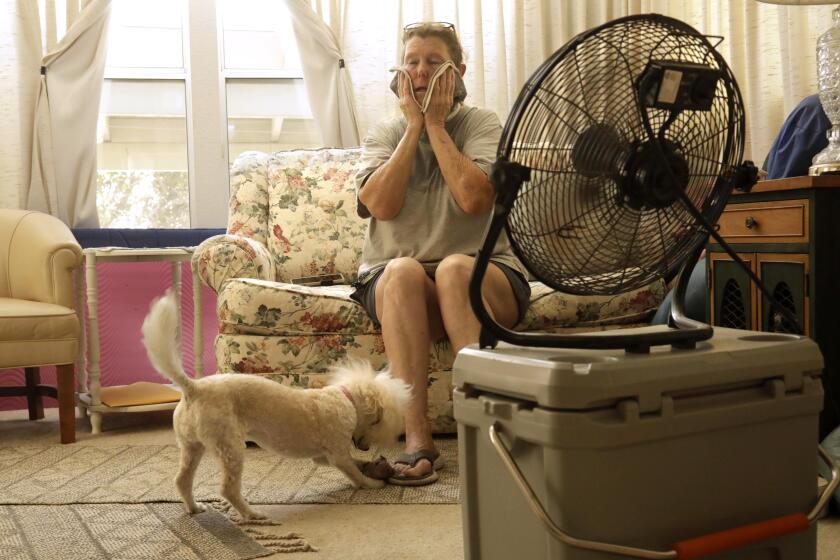As California bakes, Newsom launches $20-million campaign to warn of the dangers of extreme heat

- Share via
As California braces for its most intense and prolonged heat wave of the year, state officials are investing in new methods to warn residents of the dangers of soaring temperatures.
Extreme heat is among the deadliest of all weather-related events, with the National Weather Service recording more heat-related fatalities than deaths from hurricanes, tornadoes, floods and other climate hazards in 2022.
In California, state officials have been criticized for their response to extreme heat, which disproportionately affects children and the elderly, people with chronic illnesses, disabled people and those who are pregnant. A 2021 Los Angeles Times investigation found that heat probably caused about 3,900 deaths in the state over the previous decade — six times the official tally.
The $20-million “Heat Ready CA” campaign, launched by Gov. Gavin Newsom’s Office of Community Partnerships and Strategic Communications on Tuesday, aims to help rectify that through improved outreach, advertising and communication efforts.
“The impacts of climate change have never been more clear — the hots continue to get hotter in our state and across the West, putting millions of Californians at risk,” Newsom said in a statement. “California is launching Heat Ready CA as another tool in the state’s arsenal to protect people from extreme heat. We’re asking everyone to stay alert to changing weather and take the necessary steps to keep themselves and their families safer from deadly heat waves.”
A heat wave is expected to hit Southern California this week, bringing ‘elevated’ fire danger to the region and increasing the chance for heat-related illness.
The campaign is part of the governor’s larger $404-million investment in extreme heat, guided by the Extreme Heat Action plan unveiled last year. The Heat Ready campaign will partner with 121 community-based organizations to conduct outreach in every county in more than 30 languages through door-to-door canvassing, phone banking and other community activations, officials said.
Louis Blumberg, a climate policy advisor with the nonprofit group Climate Resolve, said he’s been waiting for a coordinated public awareness campaign from the state for nearly a decade.
“It’s a proactive step and it will hopefully save some lives,” Blumberg said.
But improved public communications are only one of several strategies outlined in the Extreme Heat Action plan, which also recommends infrastructure improvements, better monitoring of heat deaths and greater investments in shade and green space, among other measures.
Blumberg said the state is making some progress toward those goals — including $10 million toward an as-yet unveiled statewide heat surveillance system — but that more clarity and oversight are needed. A bill making its way through the Legislature, SB 306, would require regular updates of the Extreme Heat Action plan and better monitoring of progress toward its goals.
“The plan is more of a list or a catalog of what could happen, but there is no specificity or accountability, there’s no hard priorities or implementation schedule,” he said. “So, yes, this is a good start — great start, really important and timely — and there’s more we can do.”
Indeed, the public information campaign comes as the planet continues to break all-time heat records, with global average temperatures in recent days skyrocketing higher than ever recorded, largely due to climate change and the onset of El Niño, a tropical Pacific pattern associated with hotter conditions.
El Niño’s arrival is likely to make at least one of the next five years — and the five-year period as a whole — the world’s warmest on record, according to the World Meteorological Organization. Meanwhile, sea surface temperatures are reaching alarming new highs, while the amount of Arctic sea is reaching record lows. (The Canadian Arctic reached 100 degrees Fahrenheit for the first time in history on Sunday.)
“The Earth is running a fever, and from our perspective in California, we have made progress on protecting people from accelerating climate impacts,” said California Natural Resources Secretary Wade Crowfoot. “We can and will protect communities and help people protect themselves from extreme heat. At the same time, I think we have been very clear — and the governor and the Legislature have been very clear — that this is a climate emergency.”
A simmering heat wave has already engulfed portions of the United States, including large swaths of Florida, Texas and Arizona. Phoenix just saw 10 consecutive days with temperatures of 110 degrees or higher, and there’s a strong likelihood it will remain that hot for at least another week. Las Vegas is expected to soar to 117 degrees by Sunday, while Corpus Christi, Texas, may see its heat index climb to 115.
The heat is also coming for California. The National Weather Service has issued excessive heat watches for much of the Central Valley, where dangerously hot temperatures of up to 115 degrees are possible later this week. In Los Angeles, the incoming heat wave could see temperatures as high as 112 degrees in the Antelope Valley, 105 degrees in the San Gabriel Valley and 90 degrees in downtown L.A. by week’s end.
Officials said the public information campaign will play a critical role in mitigating some of the deadliest effects of heat. Similar initiatives around the census and the COVID-19 pandemic have already proved successful, said Maricela Rodriguez, senior advisor to Newsom for Civic Engagement and Strategic Partnerships.
“We found a lot of success with the model that we’re applying now, which includes not only a culturally responsive approach when it comes to communications and public awareness, but also to have a trusted messenger network that can reach people — especially in underserved communities — who can be hard to reach,” she said.
California chronically undercounts the death toll from extreme heat, which disproportionately harms the poor, the elderly and others who are vulnerable.
During extreme heat events, human bodies have to work harder to stay cool. That can lead to headaches, dizziness, nausea, respiratory problems and heat strokes, among other health issues. It is particularly dangerous when temperatures stay warm overnight, providing people with no opportunity for relief.
And though extreme heat most often affects the most vulnerable, even healthy young people can be in danger, said Tomás Aragón, director of the California Department of Public Health.
“You can be completely physically healthy, and within 60 minutes get in trouble because your body produces heat rapidly, your body has not acclimated to the high temperatures, and then all of a sudden your internal core temperature starts going up, and that’s when your organs start getting into trouble,” he said. “People really underestimate it.”
Aragón said it can be challenging for state officials to accurately account for heat-related illnesses and deaths, particularly because they can be exacerbated by underlying health issues. It often takes months to arrive at an accurate number based on death certificates and excess death data, he said.
But Blumberg, of Climate Resolve, noted that other states including Washington and Oregon already have statewide heat surveillance systems that can turn data around within a weekend. He hoped to see California’s system up and running soon, along with other efforts such as heat standards for indoor workers and a heat wave ranking system, both of which are winding their way through state agencies for approval.
“These are preventable deaths,” he said. “If we intervene properly, quickly, we can prevent people from dying.”
State officials are advising everyone in the path of the incoming heat wave to stay hydrated and stay indoors and in air conditioning as much as possible. Children and pets should never be left alone in hot cars.
Los Angeles County has opened nearly 170 cooling centers in advance of the heat wave. A list of cooling centers by county can be found here.
More to Read
Sign up for Essential California
The most important California stories and recommendations in your inbox every morning.
You may occasionally receive promotional content from the Los Angeles Times.













